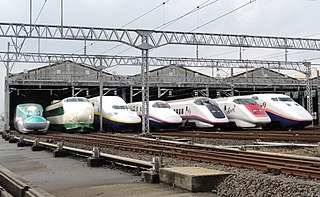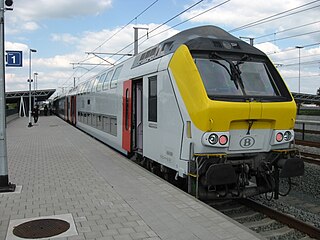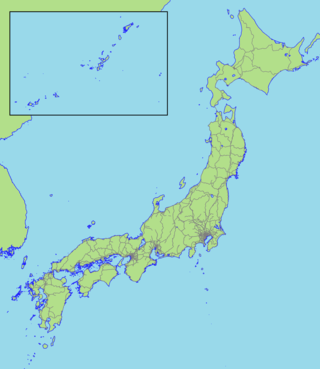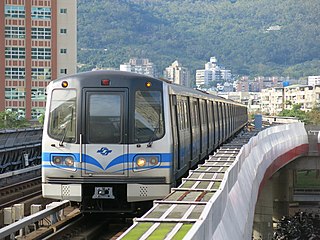
The Shinkansen, colloquially known in English as the bullet train, is a network of high-speed railway lines in Japan. Initially, it was built to connect distant Japanese regions with Tokyo, the capital, to aid economic growth and development. Beyond long-distance travel, some sections around the largest metropolitan areas are used as a commuter rail network. It is owned by the Japan Railway Construction, Transport and Technology Agency and operated by five Japan Railways Group companies.

An electric locomotive is a locomotive powered by electricity from overhead lines, a third rail or on-board energy storage such as a battery or a supercapacitor. Locomotives with on-board fuelled prime movers, such as diesel engines or gas turbines, are classed as diesel-electric or gas turbine-electric and not as electric locomotives, because the electric generator/motor combination serves only as a power transmission system.

The Hokuriku Main Line is a 45.9-kilometer (28.5 mi) railway line owned by the West Japan Railway Company connecting Maibara Station in Maibara, Shiga, with Tsuruga Station in Tsuruga, Fukui. The line formerly extended as far as Naoetsu Station in Joetsu, Niigata; however, the section between Tsuruga Station and Naoetsu Station is now operated by several third-sector railway companies. The line links the Hokuriku region on the northern central coast of Honshu, the largest island of Japan, to the regions of Kansai, Tōkai, Kantō, and Tōhoku.

The Tōhoku Main Line is a 575.7-kilometre-long (357.7 mi) railway line in Japan operated by the East Japan Railway Company. The line starts from Tokyo Station in Chiyoda, Tokyo and passes through such cities as Saitama, Utsunomiya, Fukushima, and Sendai, before reaching the end of the line in Morioka. The line originally extended to Aomori, but was truncated upon the extension of the Tōhoku Shinkansen beyond Morioka, which mostly parallels the Tōhoku Main Line. A portion of the Tōhoku Main Line is also shared with the Keihin–Tōhoku Line and the Saikyō Line.

Railway electrification is the use of electric power for the propulsion of rail transport. Electric railways use either electric locomotives, electric multiple units or both. Electricity is typically generated in large and relatively efficient generating stations, transmitted to the railway network and distributed to the trains. Some electric railways have their own dedicated generating stations and transmission lines, but most purchase power from an electric utility. The railway usually provides its own distribution lines, switches, and transformers.

Belgium has an extensive rail network. It is a member of the International Union of Railways (UIC). The UIC Country Code for Belgium is 88.

Railway electrification systems using alternating current (AC) at 25 kilovolts (kV) are used worldwide, especially for high-speed rail. It is usually supplied at the standard utility frequency, which simplifies traction substations. The development of 25 kV AC electrification is closely connected with that of successfully using utility frequency.

The Finnish railway network consists of a total track length of 9,216 km (5,727 mi). The railways are built with a broad 1,524 mm track gauge, of which 3,249 km (2,019 mi) is electrified. Passenger trains are operated by the state-owned enterprise VR that runs services on 7,225 km (4,489 mi) of track. These services cover all major cities and many rural areas, though the coverage is less than the coverage provided by the bus services. Most passenger train services originate or terminate at Helsinki Central railway station, and a large proportion of the passenger rail network radiates out of Helsinki. VR also operates freight services. Maintenance and construction of the railway network itself is the responsibility of the Finnish Rail Administration, which is a part of the Finnish Transport Agency. The network consists of six areal centres, that manage the use and maintenance of the routes in co-operation. Cargo yards and large stations may have their own signalling systems.

Rail transport in Japan is a major means of passenger transport, especially for mass and high-speed travel between major cities and for commuter transport in urban areas. It is used relatively little for freight transport, accounting for just 0.84% of goods movement. The privatised network is highly efficient, requiring few subsidies and running with extreme punctuality, though since privatisation several unprofitable but socially valuable lines have been closed by private operators.

The Ōu Main Line is a railway line in Japan, operated by the East Japan Railway Company. It connects Fukushima Station through Akita Station to Aomori Station. Since the opening of the Yamagata Shinkansen on July 1, 1992, the Fukushima–Yamagata section is sometimes referred to as the Yamagata Line. The name of the line as a whole refers to the ancient provinces of Mutsu (陸奥) and Dewa (出羽), as it connects both ends of Mutsu by passing north–south through Dewa.

The Shinetsu Main Line is a railway line, consisting of three geographically separated sections, operated by the East Japan Railway Company in Japan. It was originally one continuous line connecting Takasaki and Niigata via Nagano. Since the opening and later extension of the Hokuriku Shinkansen, sections running in parallel have either been discontinued or transferred to third-sector railway companies.

Rail transport in Hungary is mainly owned by the national rail company MÁV, with a significant portion of the network owned and operated by GySEV.

Rail transport in Slovakia began on September 21, 1840, with the opening of the first horse-powered line from Bratislava to Svätý Jur. The first steam-powered line, from Bratislava to Vienna, opened on August 20, 1848.

The Ministry of Transportation and Communications governs transportation in Taiwan.
The Gauge Change Train(GCT) or Free Gauge Train (フリーゲージトレイン, "FGT") is the name given to a Japanese project started in 1994 to develop a high-speed train with variable gauge axles to allow inter-running between the 1,435 mm (4 ft 8+1⁄2 in) standard gauge Shinkansen network, and the 1,067 mm (3 ft 6 in) narrow gauge regional rail network.

The Sakhalin–Hokkaido Tunnel is a proposed connection to link the Russian island of Sakhalin with the Japanese island of Hokkaido. Cost estimates by Russia in the year 2000 put the project to span the 45-kilometre (28-mile) strait at $50 billion.

Electrification of Australian railways began with the Melbourne and Sydney suburban lines. Melbourne suburban lines were electrified from 1919 using 1,500 V DC. Sydney suburban lines were electrified from 1926 using the same system.

The San'yō Main Line is a major railway line owned by JR Group companies in western Japan, connecting Kōbe Station and Moji Station, largely paralleling the coast of the Seto Inland Sea, in other words, the southern coast of western Honshu. The San'yō Shinkansen line largely parallels its route. The name Sanyō derived from the ancient region and highway San'yōdō, the road on the sunny (south) side of the mountains.

The Chennai Egmore–Thanjavur main line connects Chennai Egmore and Thanjavur Junction both in the Indian state of Tamil Nadu. The Chennai Egmore–Thanjavur main line is part of Chennai–Viluppuram–Chidambaram-Mayiladuthurai–Kumbakonam–Thanjavur–Tiruchirappalli line. There are several branch lines : Chengalpattu–Arakkonam links to Chennai Central–Bengaluru City line, Guntakal–Chennai Egmore section, Viluppuram–Puducherry, Cuddalore–Virudhachalam, Mayiladuthurai–Thiruvarur, and Peralam–Nagapattinam sectors. The line connects the Kaveri delta to Chennai.
Railway electrification in New Zealand consists of three separate electric systems, all on the North Island. Electrification was initially adopted by the New Zealand Railways for long tunnels; the Otira Tunnel, the Lyttelton Rail Tunnel and the two Tawa Tunnels of the Tawa Flat Deviation. Electrification of Wellington suburban services started with the Johnsonville Line and Kapiti Line out of Wellington from the 1930s. Auckland suburban services were electrified in 2014–2015. Electrification of long-distance services on the North Island Main Trunk (NIMT) dates from 1986. New long tunnels, for example the Rimutaka Tunnel and the Kaimai Tunnel, were operated by diesels, and the Otira and Lyttelton Tunnels have converted to diesel operation.


















